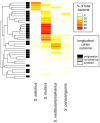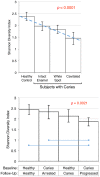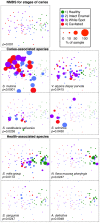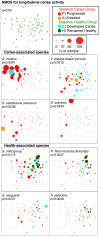Beyond Streptococcus mutans: dental caries onset linked to multiple species by 16S rRNA community analysis
- PMID: 23091642
- PMCID: PMC3472979
- DOI: 10.1371/journal.pone.0047722
Beyond Streptococcus mutans: dental caries onset linked to multiple species by 16S rRNA community analysis
Abstract
Dental caries in very young children may be severe, result in serious infection, and require general anesthesia for treatment. Dental caries results from a shift within the biofilm community specific to the tooth surface, and acidogenic species are responsible for caries. Streptococcus mutans, the most common acid producer in caries, is not always present and occurs as part of a complex microbial community. Understanding the degree to which multiple acidogenic species provide functional redundancy and resilience to caries-associated communities will be important for developing biologic interventions. In addition, microbial community interactions in health and caries pathogenesis are not well understood. The purpose of this study was to investigate bacterial community profiles associated with the onset of caries in the primary dentition. In a combination cross-sectional and longitudinal design, bacterial community profiles at progressive stages of caries and over time were examined and compared to those of health. 16S rRNA gene sequencing was used for bacterial community analysis. Streptococcus mutans was the dominant species in many, but not all, subjects with caries. Elevated levels of S. salivarius, S. sobrinus, and S. parasanguinis were also associated with caries, especially in subjects with no or low levels of S. mutans, suggesting these species are alternative pathogens, and that multiple species may need to be targeted for interventions. Veillonella, which metabolizes lactate, was associated with caries and was highly correlated with total acid producing species. Among children without previous history of caries, Veillonella, but not S. mutans or other acid-producing species, predicted future caries. Bacterial community diversity was reduced in caries as compared to health, as many species appeared to occur at lower levels or be lost as caries advanced, including the Streptococcus mitis group, Neisseria, and Streptococcus sanguinis. This may have implications for bacterial community resilience and the restoration of oral health.
Conflict of interest statement
Figures








References
-
- US Department of Health and Human Services (2000) Oral Health in America: A Report of the Surgeon General– Executive Summary National Institute of Dental and Craniofacial Research, National Institutes of Health.
-
- Casamassimo PS, Thikkurissy S, Edelstein BL, Maiorini E (2009) Beyond the dmft: the human and economic cost of early childhood caries. J Am Dent Assoc 140: 650–657. - PubMed
-
- Kanellis MJ, Damiano PC, Momany ET (2000) Medicaid costs associated with the hospitalization of young children for restorative dental treatment under general anesthesia. J Public Health Dent 60: 28–32. - PubMed
-
- al-Shalan TA, Erickson PR, Hardie NA (1997) Primary incisor decay before age 4 as a risk factor for future dental caries. Pediatr Dent 19: 37–41. - PubMed
-
- Alm A, Wendt LK, Koch G, Birkhed D (2007) Prevalence of approximal caries in posterior teeth in 15-year-old Swedish teenagers in relation to their caries experience at 3 years of age. Caries research 41: 392–398. - PubMed
Publication types
MeSH terms
Substances
Grants and funding
LinkOut - more resources
Full Text Sources
Other Literature Sources
Medical

